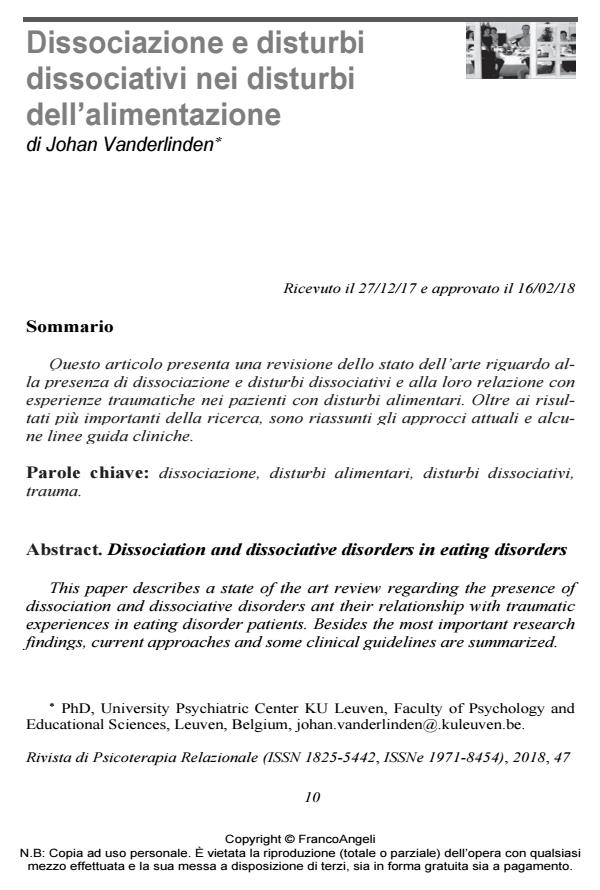Dissociation and dissociative disorders in eating disorders
Journal title RIVISTA DI PSICOTERAPIA RELAZIONALE
Author/s Johan Vanderlinden
Publishing Year 2018 Issue 2018/47
Language Italian Pages 12 P. 10-21 File size 192 KB
DOI 10.3280/PR2018-047002
DOI is like a bar code for intellectual property: to have more infomation
click here
Below, you can see the article first page
If you want to buy this article in PDF format, you can do it, following the instructions to buy download credits

FrancoAngeli is member of Publishers International Linking Association, Inc (PILA), a not-for-profit association which run the CrossRef service enabling links to and from online scholarly content.
This paper describes a state of the art review regarding the presence of dissociation and dissociative disorders ant their relationship with traumatic experiences in eating disorder patients. Besides the most important research findings, current approaches and some clinical guidelines are summarized.
Keywords: Dissociation, dissociative disorders, eating disorders, traumatic experiences
- Claes L., Muehlenkamp J.J., Eds. (2014). Non-suicidal Self-injury in Eating Disorders. Germany: Heidelberg Springer.
- Dalle Grave R., Oliosi M., Todisco P., Vanderlinden J. (1997). Self-reported traumatic experiences and dissociative symptoms with and without binge-eating disorder. Eating disorders, 5: 105-109. DOI: 10.1080/10640269708249213
- Heatherton T.F., Baumeister R.F. (1991). Binge eating as an escape from self-awareness. Psychological bulletin, 110: 86-108. DOI: 10.1037/0033-2909.110.1.86
- International Society for the Study of Trauma and Dissociation (2011). Guidelines for Treating Dissociative Identity Disorder in Adults, Third Revision. Journal of trauma and dissociation, 12: 115-187.
- La Mela C., Maglietta M., Lucarelli S., Mori S., Sassaroli S. (2013). Pretreatment outcome indicators in an eating disorder outpatient group: The effects of self-esteem, personality disorders and dissociation. Comprehensive psychiatry, 54: 933-942.
- Moulton S.J., Newman E., Power K., Swanson V., Day K. (2015). Childhood trauma and eating psychopathology: A mediating role for dissociation and emotion dysregulation? Child abuse and neglect, 39: 167-174.
- Palmisano G.L., Innamorati M., Vanderlinden J. (2016). Life adverse experiences in relation with obesity and binge eating disorder: A systematic review. Journal behavior addict, 5(1):11-31. DOI: 10.1556/2006.5.2016.018
- Pignatelli A.M., Wampers M., Loriedo C., Biondi M., Vanderlinden J. (2017). Childhood neglect in eating disorders: A systematic review and meta-analysis. Journal of trauma dissociation: 18(1): 100-115. DOI: 10.1080/15299732.2016.1198951
- Van der Hart O., Nijenhuis E.R.S., Steele K. (2006). The haunted self: Chronic traumatization and structural dissociation of the personality. New York/London: Norton.
- Vanderlinden J., Vandereycken W., Van Dyck R., Vertommen H. (1993). Dissociative experiences and trauma in eating disorders. International journal of eating disorders, 13: 187-194.
- Vanderlinden J., Vandereycken W., Claes L. (2007). Trauma, dissociation and impulse dyscontrol: lessons from the eating disorders field. In Vermettten E., Dorahy M., Spiegel D. (Eds.), Dissociation: Neurobiology and Treatment (pp. 317-333). Arlington, VA: American Psychiatric Publishing.
- Vanderlinden J. (2010). Do different psychopathological pathways in eating disorder patients necessitate different therapeutic goals and/or approaches? European eating disorders review, 18(3): 161-164.
- Vanderlinden J., Palmisano G. (2018). Trauma and the eating disorders: a literature review (chapter 2). In Seubert A., Virdi P.: Trauma-informed Approaches to Eating Disorders. NY: Springer Publications.
- Waller G., Babbs M., Wright F., Potterton C., Letter C., Leung N. (2003). Somatoform dissociation in eating-disordered patients. Behaviour research and therapy, 41: 619-627.
Johan Vanderlinden, Dissociazione e disturbi dissociativi nei disturbi dell’alimentazione in "RIVISTA DI PSICOTERAPIA RELAZIONALE " 47/2018, pp 10-21, DOI: 10.3280/PR2018-047002